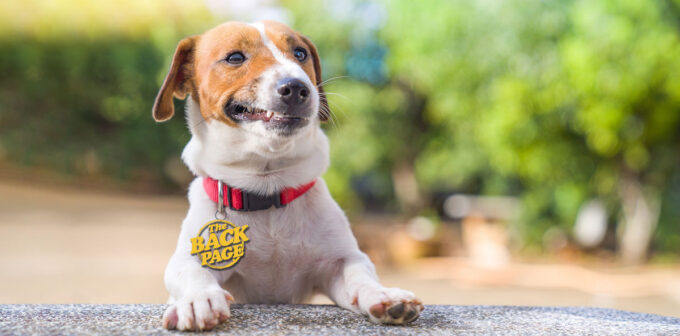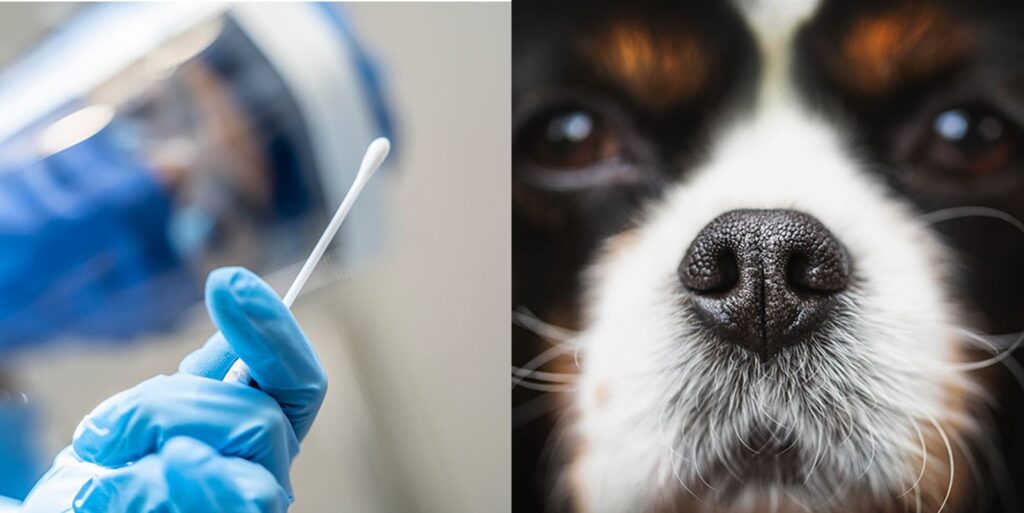
‘The gold standard is the dog.’ True in any context.
The Back Page won’t often bring you studies from the Journal of Osteopathic Medicine, but this one drew such a big collective “Awww!” from the DR team that we might have faced insurrection had we not made an allowance.
It’s a systematic review by Tommy Dickey, dog lover and emeritus professor of … geography … at UC Santa Barbara, and Heather Junqueira, founder of BioScent Inc., which trains dogs to detect cancer and other diseases including covid-19 – so not an entirely disinterested party, there.
Never mind. Dogs!!
The authors make a good case for classing dogs’ noses as one of the natural wonders of the world: with up to 50 times as many olfactory cells as humans and a third of their brains given over to scent processing (we devote 5%), they can reportedly detect “one part per trillion in n-amyl acetate … about three orders of magnitude better than possible with scientific instrumentation”. By sniffing out volatile organic compounds “that evolve into particular pathologic states” they been supposedly able to diagnose (dognose?) diseases including malaria, some cancers, diabetes, epilepsy, and Parkinson’s disease.
The authors found 29 studies involving a combined 147 deployments and 31,000 samples, which they reviewed to assess the safety, effectiveness, and practicality of using trained scent dog screening for covid and disease outbreaks more generally.
The first question they address is whether the dogs can catch covid – it being after all a respiratory virus – from the people they’re sniffing, and get sick or pass it on to other humans or animals. Their scan of the relevant studies comes up “eh, not really”.
They say the desirable traits for scent detection dogs include: “good temperament, lack of aggressiveness, obedient, sociable, independent but able to focus and follow commands, capability to detect and pinpoint low-level scent signals, adaptable to different environments, enjoy working with a handler, high search drive, and endurance and persistence in doing scent work”.
We’re stealing that copy next time we need to advertise for a journalist.
While Labrador retrievers and Belgian Malinois are the most commonly used dog, they found no obvious preference by breed for the work. In one heart-tugging example, says the accompanying press release, “a ‘problem’ pit bull terrier that had been abused found a second chance by becoming a perfectly capable covid detector”.
The age range was also wide, from six-month-old puppies to 12-year-old veterans, and there was no advantage between males and females. Samples took the form of “sweat, saliva, throat, urine, masks (sweat droplets), clothes, socks, and T-shirts”.
The dogs’ performance was marked against PCR and RATs, none of which, the authors remark, is perfect. Given the WHO recommendation that sensitivity and specificity should be above 80% and 97% respectively, they find dogs come close to this benchmark, with 92% of studies exceeding 80% sensitivity and 32% exceeding 97% specificity. But with 84% of dog studies passing 90% specificity, they find this is “at least comparable” with both PCR and RAT, citing specificity ranges of 90-100% and 58-99% respectively.
One study even found dogs beat the gold-standard PCR in accuracy, using Bayesian analysis, though without an even golder standard we aren’t sure how they knew.
One very clear advantage is speed. Remember when people were waiting a week for their PCR result? And this study that found RATs are reliable if you do three of them at two-day intervals? Here the dogs either sniff people and give a result instantly, or sniff a sample, which takes a few minutes.
In comments for the press release, Professor Dickey says dogs can even distinguish covid in the presence of other respiratory viruses.
“They’re much more effective,” he says. “In fact one of the authors that we quote in the paper commented that the RT-PCR test is not the gold standard any more. It’s the dog.”
On the downside the authors list a number of limitations that go with using dogs, including that they’re susceptible to distractions and even frustration when too few positive samples are presented, and not everyone likes dogs.
When all’s said and done, then, the only question left to answer is whether you prefer this in your face, or this:

Good boys and girls send story tips to penny@medicalrepublic.com.au.

